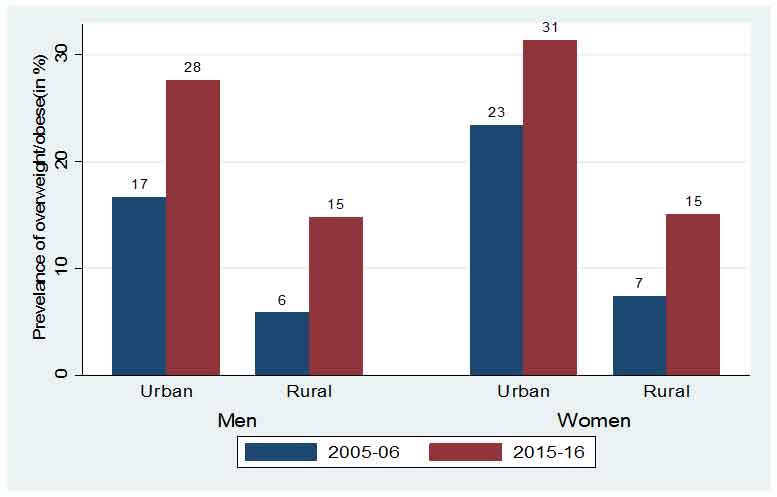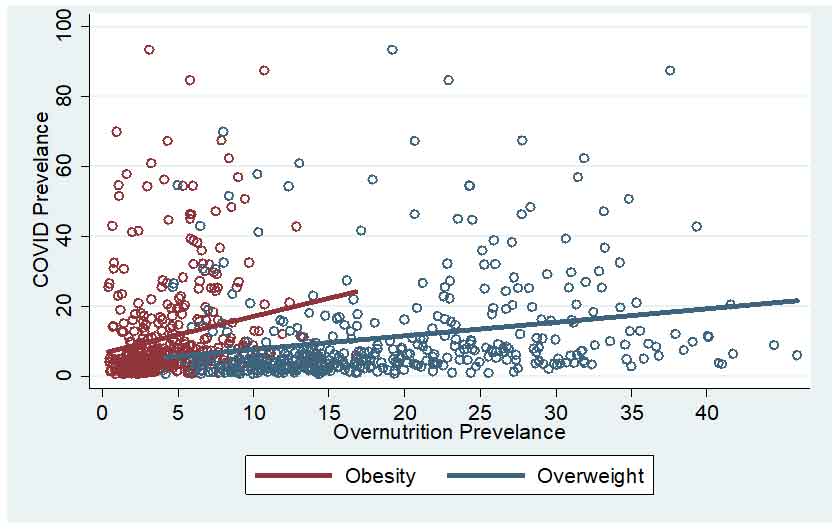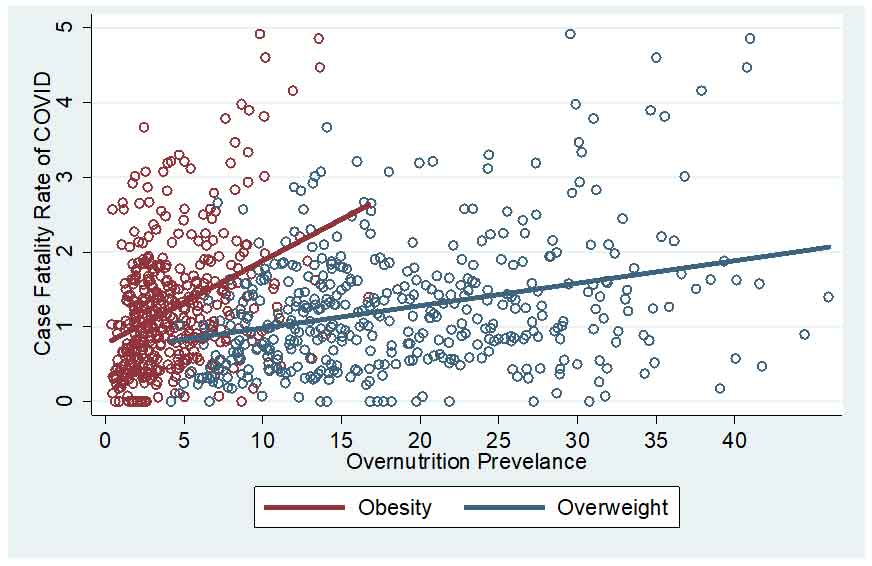Overnutrition is a major public health issue in India. Being overweight or obese has been linked to the development of health conditions that make individuals more susceptible to severe illness due to Covid-19. Using district-level data on Covid-19 and nutrition data from National Family Health Survey, this article presents evidence of a strong, significant association between overnutrition indicators and Covid-19 prevalence and case fatality rates.
Atleast one in three adults is overweight or obese in several parts of India (National Family Health Survey (NFHS)-4, 2016), and this has become a major health issue. Growing evidence suggests that prevelance of overweight and obesity in India are no longer urban phenomena, and in some states, the prevalence is comparable to developed countries (Siddiqui and Donato 2020, Aiyar et al. 2021). However, this issue has not received adequate attention from policymakers. In the context of the Covid-19 pandemic and the role played by co-morbidities in elevated mortality rates, it is important to examine the link between obesity and Covid-19.
Obesity and Covid-19
Global evidence seems to suggest that among adults aged less than 65 years (generally considered a lower-risk group of Covid-19 disease severity), obesity appears to be an independent risk factor for the severity of the disease (Simonnet et al. 2020, Zheng et al. 2020). Individuals with high body mass index (BMI)1 are more likely to have metabolic disorders (such as abnormal blood glucose, blood pressure, cholesterol) which then progress to a variety of health conditions including type 2 diabetes, cardiovascular diseases, and cancers (Salvator et al. 2020). Metabolic dysregulation due to excess body fat can impair the immune system and increase the risk of infections and respiratory illnesses (Poulain et al. 2006). Excess bodyweight reduces the lung’s capacity and since Coronavirus mainly affects the lungs, this may significantly increase the risk of mortality in Covid-19 patients (Simonnet et al. 2020).
Pooling data from about 20 studies, Popkin et al. (2020), show that the odds of individuals with obesity testing positive for Covid-19 are 46% higher than non-obese individuals. Furthermore, an individual being obese increases the odds of hospitalisation by 113%, of ICU (intensive care unit) admission by 74%, and of mortality by 48%.
As of 24 June 2021, India has reported more than 30 million confirmed Covid-19 cases and the death toll is close to 0.4 million. The reported daily cases had reduced in February 2021, but since the beginning of April 2021, India saw a huge spike with reported cases of over 0.4 million per day – the highest single-day increase in any country. Although official figures indicate that the second wave seems to be slowing down, many experts believe that the numbers are a gross underestimate, especially those from rural areas, where testing facilities are rudimentary. Moreover, it is predicted that a third wave is inevitable and may hit India by September-October 2021.
Menon (2021) investigates the correlation between BMI and early measures of the regional spread and intensity of Covid-19 across districts of India. Conditioning on a range of individual-, household-, and region-level variables, she finds that BMI is significantly associated with Covid-19 prevalence. However, the study also indicates an insignificant relationship between BMI and Covid-19 case fatality rate2 (CFR).
Our study
In a recent study (Dang and Gupta 2021), we use Covid-19 data for India to examine the relationship of excess body weight (using overweight/obesity as an indicator), with Covid-19 prevalence and Covid-19 CFR. We analyse data at the state as well as district levels, using nationally representative data from the NFHS-4 conducted in 2015-16, in conjunction with data on Covid-19 available from covid19india.org3 (till 24 December 2020). Using more current data, we contribute to the literature not just by providing evidence on the significant association between overnutrition and Covid-19 prevalence but also on the relationship between overnutrition and Covid-19 fatality rate. Additionally, we outline the differences in results when obesity is used as an indicator and when overweight is used as an indicator, and their relation with Covid-19 prevalence and CFR.
We use three main variables in the analysis: (a) overnutrition indicators as proxies for non-communicable diseases (NCD), (b) Covid-19 prevalence rates and (c) CFR due to Covid-19. We first analyse data at the state level, and then at the district level. Given that the results are similar, we only present district level estimates here.
NFHS-4 has data on height and weight for women aged 15-49 years and men aged 15-54 years. NFHS-3 (2005-06) is also used to show how the prevalence of overnutrition has changed over time. We utilise these variables to construct overnutrition indicators. BMI is used to categorise individuals into underweight, normal weight, overweight, and obese, and obtain prevalence rates of overweight/obesity among women and men. Districts in NFHS-4 are matched with the districts given in the Covid-19 data.
Figure 1 below indicates that, as expected, overweight and obesity prevalence is higher in urban areas. The proportion of overweight or obese men increased by 11% from 2005-06 to 2015-16, while among women it increased by 8%. Though the proportion of overweight or obese women is higher, the prevalence increased sharply for men between the two rounds. In rural areas, the proportion almost doubled for both women and men – from 6% in 2005-06 to 15% in 2015-16; the corresponding figures for women are 7% and 15%.
Figure 1. Prevalence of overnutrition, by type of residence, gender, and year (in percentage)

Notes: (i) Data refer to men aged 15-54 years and women aged 15-49 years. (ii) An adult is classified as overweight/obese if their BMI is ≥ 25 kg/m2.
Sources: Authors’ calculations based on NFHS-3 and NFHS-4 data.
Our empirical analysis shows that the correlation between overnutrition and Covid-19 prevalence is positive and significant (Figure 2). Moreover, if we use obesity as an indicator of overnutrition, the relationship becomes stronger. Next, we demonstrate that a positive and significant relationship exists between CFR of Covid-19 in a district and the proportion of overweight and obese individuals (Figure 3). Unsurprisingly, the magnitude of the correlation is stronger where the prevalence of obese individuals is higher.
Figure 2. Association between Covid-19 and overweight and obesity prevalence

Sources: Authors’ calculations based on NFHS-4 data; Covid-19 data are obtained from covid19india.org.
Figure 3. Association between case fatality rate of Covid-19 and overweight and obesity prevalence
Conclusion
We find a significant association between markers of overnutrition – being overweight or obese – on Covid-19 prevalence and CFR. The study corroborate other global findings, and indicate that Covid-19 has added another dimension to the impact of the prevalence of overnutrition. The WHO (World Health Organization) and CDC (Centers for Disease Control and Prevention) have included overweight and obesity as risk factors for severe and life-threatening Covid-19 infections and even the ICMR (Indian Council of Medical Research) recognises obesity as an indicator for severe cases of Covid-19.
India has been seeing an increase in cases of overnutrition in recent years. On account of stay-at-home guidelines to check the spread of Covid-19, lifestyles have become even more sedentary. Some evidence exists to suggest that increased consumption of processed foods during lockdown has escalated the risk of being overweight and obese. While the various health implications of being overweight are now well-known, the positive link between morbidity and mortality from Covid-19 and being overweight needs to be conveyed to the public to lend urgency to prevention measures taken by individuals.
Evidence has also suggested the lower efficacy of Covid-19 vaccines on overweight or obese individuals. The possibility of such vaccines producing fewer antibodies, requiring additional booster doses among this population cannot be ruled out (Pellini et al. 2021). With limited vaccines available, obese and overweight individuals may be a target group that can be considered on a priority basis, in the vaccination strategy of the country.
I4I is now on Telegram. Please click here (@Ideas4India) to subscribe to our channel for quick updates on our content.
Notes:
- BMI is defined as the ratio of weight (in kilograms) to height (in meters) squared (kg/m2).
- Case fatality ratio refers to the proportion of deaths due to a disease relative to the total number of people diagnosed with the disease in a particular period.
- This website compiles data on Covid-19 from government sources.
Further Reading
- Dang, A and I Gupta (2021), ‘Obesity and its Impact on COVID Occurrence: Evidence from India’, Institute of Economic Growth Working paper No. 430.
- International Institute for Population Sciences (IIPS) and ICF (2017), ‘National Family Health Survey (NFHS-4), 2015-16’, Mumbai, India.
- Menon, Nidhiya (2021), "Does BMI predict the early spatial variation and intensity of Covid-19 in developing countries? Evidence from India", Economics and Human Biology, 41: 100990. Available here.
- Pellini, R et al. (2021), "Obesity may hamper SARS-CoV-2 vaccine immunogenicity", MedRxiv.
- Popkin, Barry M, Shufa Du, William D Green, Melinda A Beck, Taghred Algaith, Christopher H Herbst, Reem F Alsukait, Mohammed Alluhidan, Nahar Alazemi and Meera Shekar (2020), "Individuals with obesity and COVID‐19: A global perspective on the epidemiology and biological relationships", Obesity Reviews, 21(11): e13128. Available here.
- Poulain, Magali, Mariève Doucet, Geneviève C Major, Vicky Drapeau, Frédéric Sériès, Louis-Philippe Boulet, Angelo Tremblay and François Maltais (2006), "The effect of obesity on chronic respiratory diseases: pathophysiology and therapeutic strategies", Canadian Medical Association Journal, 174(9): 1293-1299.
- Salvator, Hélène, Stanislas Grassin-Delyle, Emmanuel Naline, Marion Brollo, Caroline Fournier, Louis-Jean Couderc and Philippe Devillier (2020), "Contrasting effects of adipokines on the cytokine production by primary human bronchial epithelial cells: inhibitory effects of adiponectin", Frontiers in Pharmacology, 11: 56.
- Siddiqui, Zakaria and Ronald Donato (2020), "The dramatic rise in the prevalence of overweight and obesity in India: Obesity transition and the looming health care crisis", World Development, 134: 105050. Available here.
- Simonnet, Arthur, Mikael Chetboun, Julien Poissy, Violeta Raverdy, Jerome Noulette, Alain Duhamel, Julien Labreuche, Daniel Mathieu, Francois Pattou and Merce Jourdain (2020), "High prevalence of obesity in severe acute respiratory syndrome Coronavirus‐2 (SARS‐CoV‐2) requiring invasive mechanical ventilation", Obesity, 28(7): 1195-1199. Available here.
- Zheng, Kenneth I, Feng Gao, Xiao-Bo Wang, Qing-Feng Sun, Ke-Hua Pan, Ting-Yao Wang, Hong-Lei Ma, Yong-Ping Chen, Wen-Yue Liu, Jacob George and Ming-Hua Zheng (2020), "Obesity as a risk factor for greater severity of COVID in patients with metabolic associated fatty liver disease", Metabolism, 108: 15424. Available here.




 28 June, 2021
28 June, 2021 






By: Sajal Malhotra 30 June, 2021
The article is coherent, well-organised and very informative. The use of data and graphs helped in understanding the argument as well as grasping the big picture visually. Interesting read !